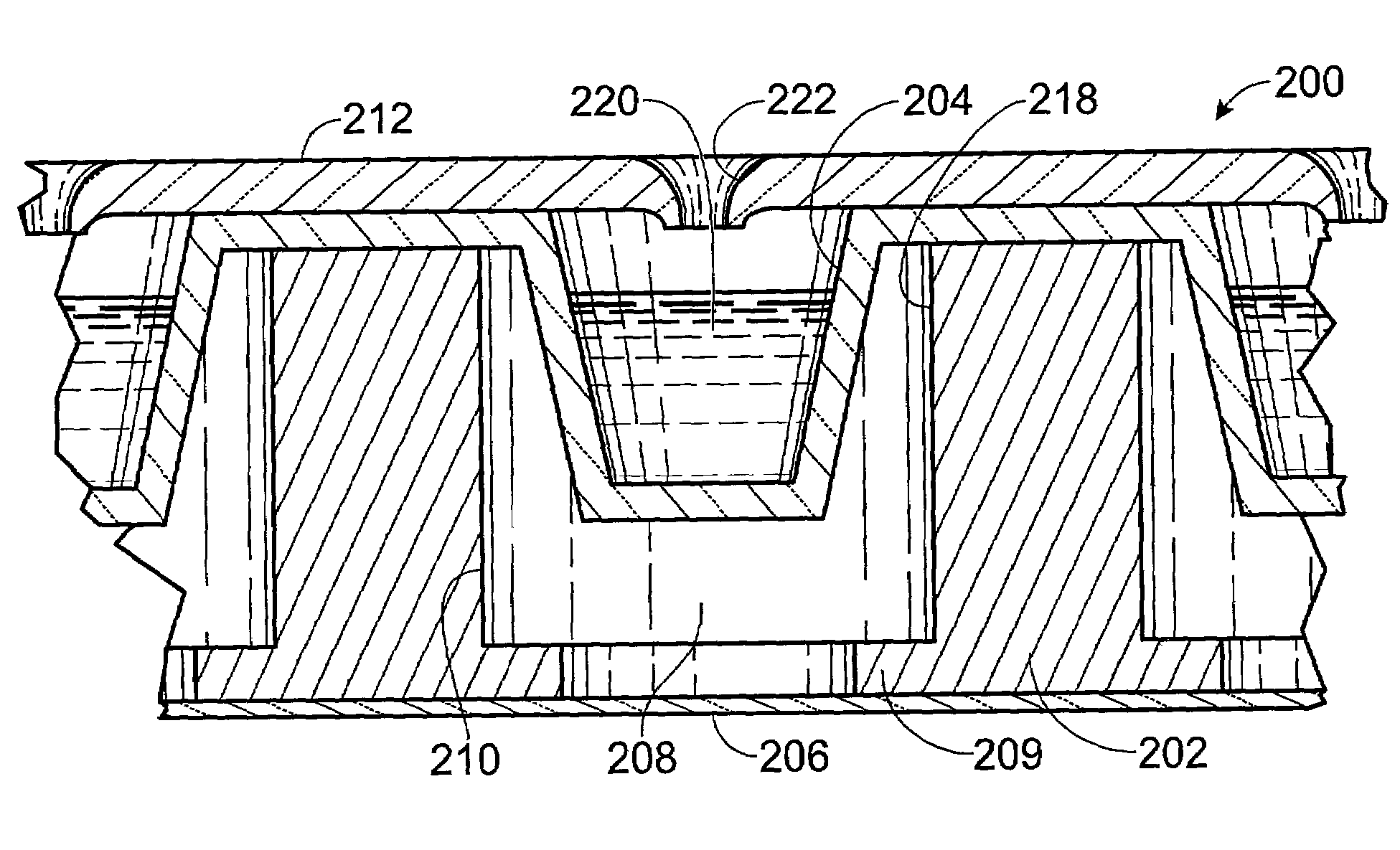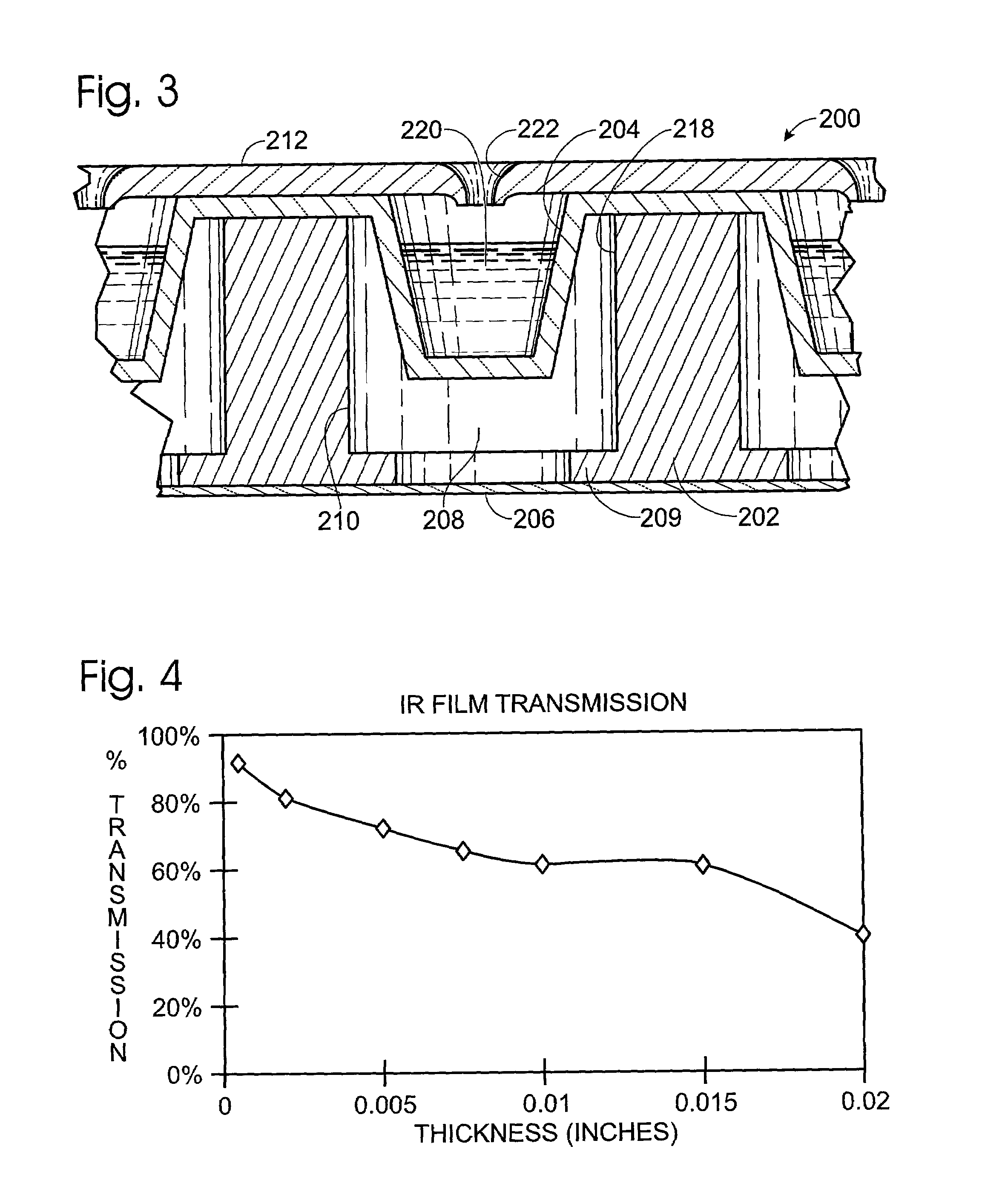Apparatus and methods for infrared calorimetric measurements
a calorimetric and infrared technology, applied in the field of calorimetry, can solve the problems of insufficient calorimeters for the measurement of inability to analyze samples too small for bomb calorimetry, and difficulty in measuring heat production and/or heat transfer in chemical and physiological processes. to achieve the effect of reducing noise in measurements
- Summary
- Abstract
- Description
- Claims
- Application Information
AI Technical Summary
Benefits of technology
Problems solved by technology
Method used
Image
Examples
example 1
[0073]This example describes a preferred sample holder for use in measurements of thermal processes, including chemical and physiological processes.
[0074]FIGS. 2 and 3 show a sample holder 200 constructed in accordance with aspects of the invention. The sample holder includes a high thermal mass frame or base 202, a plurality of sample wells 204 and a corresponding plurality of windows 206, trapped volumes 208, reference regions 209, and opaque coatings 210, and a cover 212.
[0075]Frame 202 is the main structural component of sample holder 200. The frame generally may be sized and shaped as desired, for both convenience and utility. Frame 202 is sized and shaped to form a microplate, enabling the sample holder to be used with standard microplate equipment, such as handlers, washers, and / or readers, among others. A preferred frame is substantially rectangular, with a major dimension X of about 125–130 mm, a minor dimension Y of about 80–90 mm, and a height Z of about 5–15 mm, although...
example 2
[0086]FIG. 5 shows results from an experiment designed to measure thermal cross talk caused by heat conduction through the sample plate. The experiment was performed using a top-read thermal-imaging apparatus fitted with a quantum well (QWIP) infrared radiometer from FLIR Systems. The figure shows thermal images of two plates containing a fluid that evaporates when in contact with dry ambient air. Here, relative temperature is denoted by shading, where samples with relatively high temperatures have increased shading, and samples with relatively low temperatures have reduced shading. Plate 1 (left) is fabricated using a thin polymer insert and a high thermal mass base, as shown in FIGS. 2 and 3. Plate 2 (right) is a standard commercially available 96-well microplate fabricated from a polystyrene polymer (Costar 3628). The thermal images show that plate 1 provides significantly better thermal isolation than plate 2. In particular, the wells in plate 1 are insulated from the surroundin...
example 3
[0087]This example describes results of an experiment designed to test the effects of evaporation on the apparent temperature of samples positioned in wells in a multiwell plate.
[0088]The experiment was performed using the top-read thermal-imaging apparatus and low cross-talk multiwell plate of Example 2. In these experiments, sets of adjacent wells were filled with fluids having various evaporation characteristics or else were covered with a high-emissivity tape, as shown below.
[0089]
Here, A=alcohol, W=water, O=mineral oil, and T=tape. Alcohol and water are prone to evaporation, whereas mineral oil and tape are not. The apparent temperature in each well was measured at fixed intervals during a 15-minute period.
[0090]The data show that evaporation affects the apparent temperature of the samples. Specifically, the apparent temperature of wells containing water or alcohol was about 27° C., whereas the apparent temperature of wells containing mineral oil or tape was about 29° C., or ab...
PUM
 Login to View More
Login to View More Abstract
Description
Claims
Application Information
 Login to View More
Login to View More - R&D
- Intellectual Property
- Life Sciences
- Materials
- Tech Scout
- Unparalleled Data Quality
- Higher Quality Content
- 60% Fewer Hallucinations
Browse by: Latest US Patents, China's latest patents, Technical Efficacy Thesaurus, Application Domain, Technology Topic, Popular Technical Reports.
© 2025 PatSnap. All rights reserved.Legal|Privacy policy|Modern Slavery Act Transparency Statement|Sitemap|About US| Contact US: help@patsnap.com



